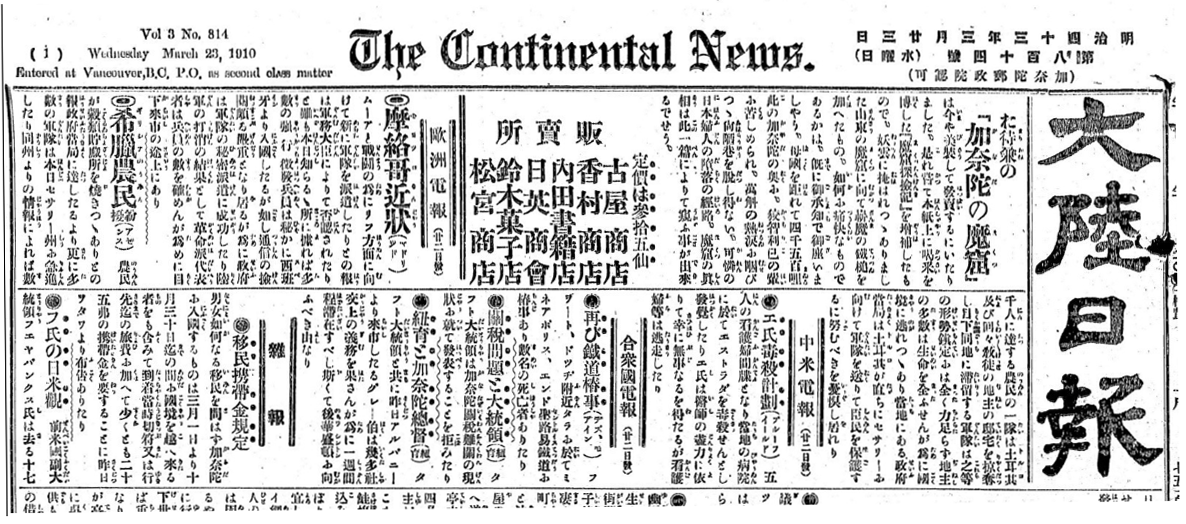
Image: Tairiku Nippo’s issue (23 March, 1910) announcing the publication of Brothels in Canada in the upper right section of the front page. The announcement lists six Japanese-owned local businesses where a copy can be purchased. The book was sold at 35 cents.
画像: 大陸日報が1910年3月23日付の一面で、『加奈陀の魔窟』出版を告知。6軒の日系商店が購入場所として紹介されている。一冊35セント。
Images courtesy of the University of British Columbia Library Digitization Centre and its generous donors.
This module looks at the two-part newspaper series “Makutsu Tankenki,” or “Exploration of Devil Caves” (November 19, 1908 – February 13, 1909; March 1 – April 6, 1912), which was published in the Japanese language paper Tairiku Nippō (Continental Daily News) for members of the Japanese migrant community in Vancouver, Canada, and beyond. This series debuted in the broader historical context of Canada’s nation-building – led by European settlers – which involved colonization of Indigenous lands, displacement and genocide of Indigenous peoples, and mobilization of cheap labour provided by migrants from Asia.
Written by journalist Shōhei Osada, “Exploration of Devil Caves” exposes detailed stories of Japanese brothel owners, managers, pimps, procurers, and sex workers in Canada. Osada believed that Japanese prostitution exacerbated the racism against Japanese people that existed in the dominant settler society and wrote the series to shame and eradicate such businesses. This, however, is only part of the story. The dramatized stories of the Japanese brothels and the individuals involved in sex trade ended up becoming a popular source of entertainment among readers. After the first part was released, it was re-edited, with a new introduction and with the readership in Japan in mind, and published as a book, Kanada no Makutsu, or Brothels in Canada (1910).
Being objects of condemnation, shaming, and entertainment, Osada’s depiction of individuals engaged in sex trade is extremely derogatory. Beyond his original intention, however, this publication documents the history of transnational sex trade in ways that other archival sources hardly do and provides us with one of few opportunities to recognize the lives of those who survived the stigmatized, underground economy in the transpacific world at the turn of the 20th century. This module is interested in reading a story of such an underrepresented history against the grain (i.e. recognizing biases that exist in the original archival source and seeking alternative ways to imagine the lives that are documented).
This module consists of the following components:
- Background #1: Interactive Map
- Background #2: Critical Glossary
- Lecture Video #1: “Sex Workers, Waitresses, and Wives: The Disciplining of Women’s Bodies in Japanese Language Media in Vancouver (1908-1920)” by Ayaka Yoshimizu
- Lecture Video #2: “Reimagining Japanese Prostitutes: The Photographs in Devil Caves in Canada (1910)” by Asato Ikeda
- Approaching Primary Sources: Guiding Questions
- Additional Resources
このモジュールでは、主にカナダのバンクーバーやその近辺に住む日系移住者をターゲットとして出版されていた日本語日刊紙『大陸日報』に掲載されたコラムシリーズ「魔窟探検記」の正編(1908年11月19日〜1909年2月13日)と続編(1912年3月1日〜4月6日)を扱う。このシリーズが出版された背景には、ヨーロッパからの入植者率いるカナダの国民国家建設のプロジェクトがあり、先住民の土地の略奪、虐殺、強制移住、そしてアジアからの安価な労働力の動員が行われていた。
「魔窟探検記」では、記者長田昌平が、カナダで活動をする日系娼館経営者、運営者、ピンプ、斡旋業者、「娼婦」についての詳細を「すっぱ抜く」様子が伺える。長田は、日系「売春」業が、白人入植者による日系移住者への人種差別を助長していると考え、それに携わる人物を辱めることで「売春」を廃業に追いやろうと試みた。一方で、「売春」業に関わる人物のドラマは、読者にとっては娯楽としても支持されたようだ。正編は、1910年、日本の読者も想定して再編され、改めて『加奈陀の魔窟』という題で本として出版された。
当シリーズでは、性産業に関わる人物は、批判、恥さらし、娯楽の対象として軽蔑的、差別的な表現で描写されている。しかし、今日において、19世紀末から20世紀初頭にかけて環太平洋地域をまたがるアンダーグラウンド経済を生き延びた人々の歴史を知る手がかりは数少なく、この資料は、当時の著者の思惑を超えて重要な意味を持つ。このモジュールでは、これまでスティグマ化され軽視されてきた歴史を、資料に含まれるバイアスに抗って読みながら、ここで描かれた人々の暮らしを新たに想像し直す方法を模索する。
モジュールは以下の内容で構成されている。
- 背景 #1:インタラクティブ地図
- 背景 #2:批判的語彙集
- 講議動画 #1:「娼婦」・ウェイトレス・妻:女性の身体をディシプリンする日本語メディア(1908-1920年バンクーバーの事例)(講師:美水彩加)
- 講議動画 #2:日本人娼婦像を読み解く: 『加奈陀の魔窟』(1910)のポートレート写真(講師:池田安里)
- 一次史料深掘り:質問集
- 追加資料